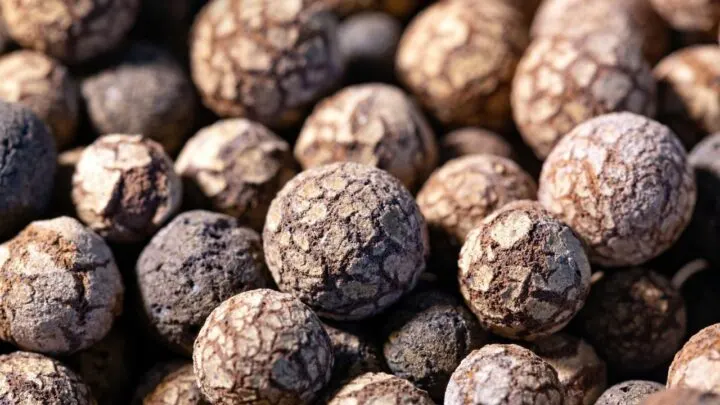Lightweight expanded clay aggregate or, Leca, is a medium in which you can grow plants.
But what is leca exactly?
Leca are baked balls of clay.
Leca has a pH level of 7 and is free of nutrients.
It works great for plants if you know how to use it properly!
I myself have been using leca for several years in passive and active hydroponic systems as well as an amendment to potting soil.
In this article, I will look at what exactly Leca is and how you can use it for your plants with all its pros and cons.
What is Leca?
Leca stands for “Lightweight expanded clay aggregate” and has been invented in 1917 in Kansas City, Missouri. Leca is balls of baked clay that were made by heating clay at 1,200 °C. They are available in different sizes and densities. Leca is a medium to grow plants hydroponically without soil. If the system is not watered automatically,we speak of a passive hydroponics system. The soaked leca balls in such as system water the plants passively through the capillary effect.
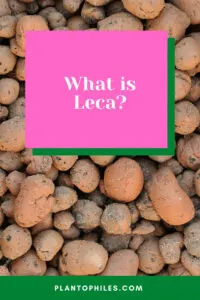
What is Leca
Table of Contents
Leca Balls
The clay balls are made by being tumbled and heated inside a rotary kiln. Leca is inorganic and is not likely to rot or break down.
The balls are porous and capable of not only absorbing water but also nutrient
Mediums such as peat moss, soil, or bark contain nutrients, whereas Leca balls do not.
The clay balls are not able to provide nutrients to plants unless it has been added to the water used when soaking them.
You can grow your houseplants 100% in leca or you can use them to make your potting soil airier and more well-draining according to Oaksterdam University.
The smaller the leca particles, the more water they can hold.
A study done by the American Society for Horticultural Science found out that leca particles between 4-8mm were holding more water compared to leca particles between 12 to 18mm.
You can conclude that the smaller leca balls are, the more water they are able to hold.
You can therefore adjust the size of leca balls used depending on the needs of the specific plant you want to use them for.
Why Leca is Useful for Plants?
You may be doubting what benefit a bunch of clay balls could possibly have for your plants.
Well, there are a plethora of reasons as to why Leca is beneficial!
Firstly, the biggest benefit of using Leca is that it allows plenty of airflow and oxygen to reach the plant’s roots.
This encourages the growth of roots.
It is also known to reduce fungus and bacteria growth.
There are little to no wasted nutrients from fertilizers because Leca acts as capillaries.
The clay balls soak up the water that has been enriched with nutrients and easily deliver it to your plant’s roots.
Proper watering of your plants is made easier and checking in on them is simplified.
Whenever there is no more water present at the bottom or false bottom of your pot or saucer you wait 2-3 days and fill it up again.
This way you ensure that the roots of plants never get too wet and have a chance to dry up.
In addition you will encourage extra root growth as the adventitious roots will look for water and will grow down the pot.
This is not guaranteed if the pot and the leca stay wet constantly.
Also, the risk of your plant being affected by pests is reduced because most pest lay eggs in soil and might not fancy the leca.
However truth be told, you can still have plants infested with thrips.
I am speaking based on my personal experience here, unfortunately.
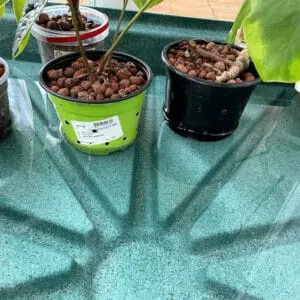
Ebb and Flow Hydroponics System using leca as a medium
A Quick Overview of Leca
There are always positives and negatives to a product. Here is a quick overview of what benefits and disadvantages Leca has.
The pros of using Leca
- The risk of pests is reduced
- Plant care is made easier
- Week-to-week maintenance is reduced
- The leca waters the plants constantly through the capillary effect
- Easier to take you plants out and check on the roots
- It is long-lasting and reusable
- Not as messy compared to soil
- Allows for constant airflow to the roots
- Full control over the pH and nutrient balance
- Retain moisture but encourage drainage
- Sterile
- Natural and renewable
- Fairly inexpensive
- Easier to remove leca from roots compared to soil if you want to repot
- Repotting in a bigger pot is a breeze
The cons of using Leca
- Transition can be pricey
- Transition from soil to leca can be risky as there is always a risk of plant shock
- Plants in leca grow water roots that are not compatible with soil
- Requires specific hydroponic fertilizer
- May require new equipment such as pots
- More effort to get started
- The initial cleaning of the leca can be messy
- Nutrients and salt buildup after a while
- Excellent drainage qualities may be too dry for certain plants
- For some plants, leca balls might be too big.
- Clay is strip-mined
Benefits of using Leca in detail
Less Pests
Pests are drawn to rotting roots and soil.
Roots of plants grown in Leca are less prone to root rot.
With the risk of root rot minimalized, there is no attraction for pests.
Also, Leca is not a live-growing medium.
Unlike soil, which is organic matter filled with nutrients, the clay balls do not have any living organisms and therefore provide nothing of interest for any bugs or pests.
As for pests that thrive in environments that are dry, Leca creates a humid environment without the effort of misting.
You may think that because the Leca balls absorb the water, the environment around your plant will be ideal for dry-environment-loving pests.
This is untrue.
Because of the gaps around the clay balls, evaporation has plenty of opportunities to take place.
With evaporation taking place, the plant’s immediate environment stays humid which rules out the risk of attracting pests like spider mites.
Plant care is made easier
As Leca regulates moisture, there is less risk of accidentally overwatering your plants.
The only thing you have to do is to fill up the water reservoir once it is empty.
I usually let the water reservoir empty for 2-3 days to encourage root growth as described above.
When growing plants in Leca, over-and underwatering becomes rarer.
You don’t have to remember when and how much to water as you can just check the water reservoir.
If the water reservoir is not easily visible you can buy a water indicator that will tell you when the reservoir is empty.
The only 2 challenges I experienced are how to fertilize and nutrient buildup.
Since Leca does not contain any nutrients you will need to add additional nutrients to your plants.
The water itself will contain some nutrients but there are many more nutrients in the soil.
You will also need a fertilizer specifically for hydroponic systems called hydroponic nutrients.
As other or regular fertilizer will account for nutrients already in the soil.
Hydroponic fertilizer contains extra macro- and micronutrients.
Without adding fertilizer your plants will eventually stop growing.
This leads me to the second challenge I faced.
Nutrient buildup.
Afer a while you will see white crystals forming on your leca balls and most heavily on the surface of the pot.
These are salt and minerals that are building up that will also form on the roots of your plants.
It is recommended to flush the leca and your plants roots every 3-4 weeks with water low in nutrients.
Otherwise, the buildup will become so heavy that the roots become shielded off the nutrients and the water and will not be able to absorb any nutrients anymore.
So give you plants and pots a good rinse every once in a while.

Monstera Thai Constellation growing in leca. Look at the roots!
Week-to-week maintenance is reduced
Plants grown in soil require regular maintenance in the form of watering.
The regularity of this maintenance can vary from every two to three weeks to as often as every day or two.
Most people will water their plants once a week I assume.
Leca, on the other hand, absorbs water and then regulates the moisture.
Your plant is able to access and absorb the water it requires on its own and will have constant access to it.
Depending on the reservoir it may take 2-4 weeks until you have to water again.
This is also a big benefit if you like to go on holiday as you can easily leave your plants alone for 2-4 weeks and you won’t need a plant nanny.
It is long-lasting and reusable
Unlike soil that eventually runs out of nutrients and needs to be replaced, Leca is reusable.
Although the Leca itself does not have any nutritional value, it is 100% reusable!
When repotting a plant, if it was grown in soil, the soil would have to be disposed of and replaced with fresh soil.
With Leca, the plant, as well as the clay balls it is grown in, can simply be transferred to its new pot.
This is not only true for repotting.
Leca can also be reused for a different plant!
Provided the clay balls are cleaned and properly sterilized beforehand, they can be used over and over again.
Leca can basically last forever.
Easier to water your plants properly with leca
Leca allows the plant grown in it to drink as much water as it wants, when it wants, without the immediate risk of root rot.
Even if you add more water to your plant’s pots and the Leca balls are still full, the plant will not be overwatered.
One important thing is that you should always just water below the line where the roots are.
When you first place your plants into leca make sure that you place a few inches of leca first and only then add in the plants with their roots.
If the roots sit in water constantly they might rot.
Easier to check the roots of your plants
You have the benefit of easily accessible roots when using Leca.
If you wanted to, you can take a plant out of the leca and check on the roots.
With soil this is a cumbersome process.
As the grown roots are water roots they seem to be more forgiving as they are used to be in touch with air constantly anyways.
However, I do not recommend taking plants out of their pots if not necessary.
But sometimes this might be necessary when a plant is not doing well or when you are not sure if it is rooting.
I usually have that problem if I take a pot that is too big and the root system of my plant is too small.
In such a case the roots and the water might not meet and the plant will dry out.
The best indicator I found to check if a plant is successfully rooted in leca is when it grows new leaves.
Plants only do this when sufficient roots have formed.
The other more obvious indicator is when roots are growing out of the pot and start to venture into the false bottom or water reservoir.
The perfect amount of water and nutrients are provided
As previously mentioned, Leca distributes moisture and the plants are able to access and absorb as much as they desire as often as they desire.
The same is true for nutrients.
The nutrients are then absorbed with the water, into the Leca and then distributed as the plant requires it.
So, your plants will constantly be drawing both food and water from the Leca at a rate that suits them.
Because these clay balls are nutrient-free, fertilizer needs to be added to the water that the Leca balls are soaking in.
In order for the max. amount of nutrients to be taken up by the roots of plants in hydroponic systems, a water pH of 5.5-6.0 needs to be present.
I have bought a pH meter do determine the pH level of the water I use and I treat and adjust it with a pH down product for hydroponics that you can buy.
A pH up product is not needed as the pH level of water from the sink is always too high (around pH 10).
So if I need a higher pH level I just add more water from the sink.
To get the amount of nutrients in the water right I use an EC meter.
EC meters measure the potential of electrical current in the water or electrical connectivity.
This tells you how dense the nutrients in the water are.
I aim for an EC level between 0.8 – 1.2 for my ebb and flow hydroponics system.
The fewer roots the plants have and the slower they grow (eg in autumn and winter) the lower the EC level should be.
Kudos got to Nige or UrbAn_gr33n on Instagram that helped me out a lot at the beginning with his wealth of knowledge.
He also is able to grow the biggest plants with his ebb and flow system.
Check him out on IG if you haven’t yet.
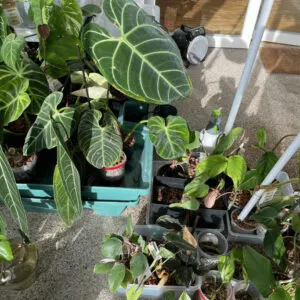
Growing houseplants in leca in an active and passive hydroponics system
Less storage space required
Plants can be very particular about the kind of soil they are grown in.
Often times it is necessary that you have more than one kind of potting soil as your plants have different needs.
Although there is the option of an all-purpose type soil, not every plant likes to be planted in them.
Leca, however, can be used for just about any type of plant!
When using Leca, all you need is enough to fill your desired pots.
And because it is reusable, you will not likely need to store any extra for repotting.
The only reason you may need more is if you get more plants!
Not as messy
When repotting your plants or even just watering them, when they are grown in soil it is bound to make a mess.
It is often the case that even when the utmost caution is being taken to avoid spillage, some soil escapes and makes a mess on your floors or countertops.
There are also quite a few people that are either allergic to soil or at least do not want to have soil in their homes.
With Leca, there is no risk of spillage when topping up the water in your plant’s pot.
The only messy part about the clay balls is a bit of dust in the beginning which ceases to be problematic when the balls are soaked and rinsed properly before using them.
Allows for ample amounts of oxygen to reach plant roots
The clay balls not only have gaps between them when placed inside of a container, but they also have air pockets inside.
They are porous and have a honeycomb structure inside.
These spaces allow for ample amounts of oxygen to get to the plant’s roots.
With adequate oxygen, healthy growth is promoted and the risk of fungal or bacterial infections is reduced, if not prevented.
This is especially important and beneficial for epyphites.
These are plants that grow on other plants and objects and grow air roots.
These roots are not used to be fully submerged in soil and need constant airflow.
Full control over the pH level and nutrient balance
Because Leca is inorganic, they do not break down.
The clay balls are also chemically inert and therefore do not provide plants grown in them with any nutrients.
Nutrients need to be added to the water that is absorbed by the Leca balls for them to be able to provide nutrients.
With that being the case, you have the ability to completely control and adjust the nutrient balance and the pH levels as is needed.
But you will have to get active and actually do it.
Easy to use
Leca is super straightforward to use.
All that is required before use is for the balls to be rinsed and then soaked.
After this is done, the balls can be added into a pot with your plant
Make sure to have at least 2-3 inches of clay balls in the bottom so the plant roots are elevated.
Add water to the water reservoir and enrich it with nutrients.
Occasional cleaning can be done by simply rinsing the leca.
This is to remove any excess salts or plant matter that has been collected over time.
Especially in the beginning when transferring plants with soil roots they will start to shed and grow into waterroots.
The shedding from these roots needs to be removed after 3-4 weeks or else it might become a problem.
Because the sheddings could decompose and rot and then infest the water in the water reservoir and affect other plants and roots as well.
Retains moisture but encourages drainage
These balls soak up water and distribute the moisture as needed.
Once full, the gaps between the balls in the pot allow for any excess water to drain to the bottom.
From there, the balls will continue to soak up the water leftover as the plant absorbs moisture from them.
This creates an environment where your plant will always have access to the water it needs without physically soaking in water consistently.
I love this ability because providing enough but not too little water can be a problem.
In the beginning, I always overloved my plants and gave them too much water.
In combination with dense potting soil this can become a big problem aka as root rot.
Sterile
Leca is a sterile material and therefore does not contain any diseases or pests.
There is no reason to stress about them contaminating your plants.
But this doesn’t mean that disease and pests cannot settle after you started growing plants in it.
However, at least the initial risk is lower and leca is also not a preferred medium for pests to settle.
Natural and renewable
Clay, being a natural resource and material means that Leca is a growing medium that is completely renewable.
Fairly inexpensive
Because Leca balls are capable of lasting a lifetime with proper care, they work out to be quite inexpensive in the long run.
The intial investment into leca can be quite substantial, however.
Disadvantages of Leca
Transition can be pricey
Although they can last forever, Leca costs quite a bit more than regular soil.
At least in the short term as discussed.
In order to transition all your plants to the clay balls medium, there will be a hefty cost initially.
Requires fertilizer and of a special kind
Leca does not provide any nutrients for your plants.
Fertilizer needs to be purchased and added in order for your plants to eat.
But, not just any fertilizer will do.
It is necessary for liquid or hydroponics fertilizer to be used. This can also work out to be quite costly.
May require new equipment such as pots
Because the Leca will be doing the watering of your plants for you, pots with drainage holes will not work.
The water needs to be contained in your plant’s pot in order for the clay balls to soak it up when they need to.
A lot of people use pots with inner pots such as net pots.
This combinations works quite well.
You can either build and combine it yourself or buy a ready-made ensemble.
It may also be necessary to invest in a pH level tester.
It is important that you keep a constant check on the pH level of the water provided to your plants.
Inaccurate pH levels will affect the nutrient availability of your plants.
More effort to get started
Unlike soil that is ready to use, Leca needs some preparation before you can plant your plants in it.
When using Leca for the first time, the balls need to be washed to remove the dust.
This process could be fairly time-consuming depending on the quantity being cleaned.
A process that is typically open the bag, grab the medium, and put it into a pot with your plant is drawn out.
It now becomes a case of opening the bag, grabbing the medium, washing it, letting it soak a bit, and then putting it in a pot with your plant.
Can be heavy
When the clay balls have soaked up all the water they can, they may end up being quite heavy.
This makes them unsuitable for use in very large containers, specifically ones that need to be moved around.
Cleaning can be messy
Although overall Leca is not messy when it comes to watering or repotting, they are still messy.
There can be quite a bit of red dust that comes off whilst washing the clay balls.
If the balls are not washed properly, any remaining dust can clog up your hydroponics system.
Obviously, this will only affect those who use Leca for that type of growing.
Clay is strip-mined
Even though the clay itself is a natural material and it is renewable, the way in which it is collected is not ideal.
Clay used to make Leca is strip-mined.
This process of mining does not have a positive impact on the environment.
Excellent drainage qualities may be too dry for certain plants
Some plants may not be suited for growing in Leca as the environment created may be too dry.
Because of the drainage qualities, certain plants may not find it satisfactory to draw moisture from the clay balls.
Or it might be too wet as the roots stay almost constantly humid unless you wait a couple of days before refilling the water reservoir when empty.
This is what I am doing.
How to Use Leca
Leca is a fairly simple material to use but there are a few things that should be noted.
The first step in the process is to rinse the Leca.
This should be done under running water with the clay balls in a strainer.
Continue rinsing until the water that runs through is clear.
The Leca balls then need to be saturated in water.
Soaking the clay balls can be done over a few hours or they can be left overnight as long as they are fully saturated.
Saturating opens the pores of the balls and allows them to expand.
When your clay balls are ready, prepare your plant for the transition.
This should be done by removing the plant from its pot and cleaning its roots.
Carefully trim away any dead or damaged roots and untangle those that remain.
Remove all the dirt from the roots before transitioning a plant to leca.
Because remaining dirt on the roots can lead to root rot in leca!
Fill your desired pot, one without drainage holes, to two-thirds of the way with Leca. Shake the pot around a bit to settle the balls.
Carefully place your plant in the pot, holding it so that the top of its roots are level with the rim of the pot.
Gently scatter the roots so that they lie loosely around the leca.
Fill the pot the rest of the way to the rim with more Leca balls. Shake the pot lightly again to settle the clay balls once more.
Do not press down the balls as they do not compact like soil. Pushing down the balls could damage the roots of your plant.
Next, mix some water with an adequate fertilizer. Remember to use a liquid or hydroponic fertilizer.
Check the pH level of the enriched water to make sure it is adequate for your plant’s needs. This may take some practice to get it exactly right.
Pour the nutrient-enriched water over the Leca balls in the pot with your plant.
Be sure to only fill the pot to just below the reach of your plant’s roots.
You do not want your plant’s roots to be sitting in water. This concludes the transition!
It is necessary to ensure the Leca your plants are grown in always has access to nutrient-enriched water.
It should take some time before the water is depleted but the Leca should never be allowed to dry out completely.
Without water to absorb, the Leca will not have moisture to supply to your plants and will in fact begin to draw the moisture out of your plants.
You should also rinse your clay balls fairly regularly.
This will clean them of any unwanted plant matter or build-up of excess salts or nutrients.
The Leca should also be washed thoroughly or sterilized before being reused for a different plant.
Which Plants Grow Best In Leca
Most plants will do well when grown in Leca. I grow almost all of my aroid in leca in fact.
I have lots of different Monstera and also Philodendron growing in leca.
The latest transition was some of my crawling Philodendr such as Philodendron Gloriosum, Philodendron Mamei, and Philodendron Luxiurians.
I was worried because of the very thin roots of these specimen and because the stems are partly submerged in the leca.
I was worried about root rot and also that the leca balls are too coarse (too big).
But they just seem to do fine and are pushing out new leaves on a constant basis.
The biggest challenge will be to ensure your plant has access to its desired amount of sunlight and the right amount of nutrients.
Typically, plants that prefer or require conditions that are consistent or are sensitive to overwatering do exceptionally well in Leca.
To name a few plants that grow well in Leca are Spider Plants, Philodendrons, Monstera deliciosa, keets, kale, Spring onions, bell Peppers, devils ivy, spinach, tomatoes, mint, and orchids.
One last word regarding orchids.
I probably achieved the best growth with an orchid in Leca I ever had. I will share a picture below.
Never did I have more green healthy roots and flower stems than when I was growing orchids in Leca instead of orchid bark.
They just seem to love it!
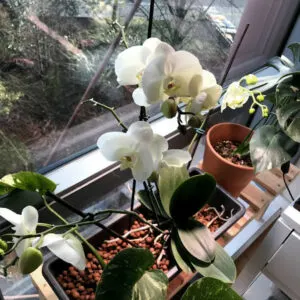
My Phalaenopsis orchid growing like crazy in leca
Final thoughts
Lightweight expanded clay aggregate may not be the growing medium for all, but it certainly is an amazing solution if you manage to get the fertilization right and are aware of the benefits and shortcomings of using leca.
The benefits or pros of using Leca out-weight the negative aspects for sure.
It may cost more initially, but you will be saving in the long run.
Not only on purchasing a growing medium but by reducing the risk of unfortunately losing a plant to improper care.
Leca has been successfully used for years and may just be the way of the future.
All you need to do is give it a try for yourself!

Daniel has been a plant enthusiast for over 20 years. He owns hundreds of houseplants and prepares for the chili growing seasons yearly with great anticipation. His favorite plants are plant species in the Araceae family, such as Monstera, Philodendron, and Anthurium. He also loves gardening and is growing hot peppers, tomatoes, and many more vegetables.

